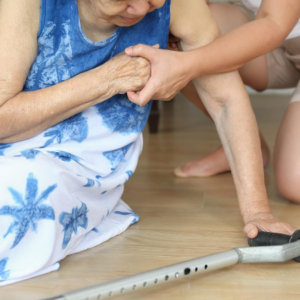10 Tips For Preventing Falls

Did you know that 1 out of 3 seniors will fall this year, but fewer than half of them will make this prevention a priority when consulting with their doctors?
One of our most devoted tea friends died earlier this year. She was in her 80’s and had gotten up in the night to take care of a cricket that had gotten into her bedroom and was keeping her awake. She fell in the process …. and broke a bone in her lower back. That fall started a serious downward spiral of overall health problems that she eventually passed from. We’re so sad about that!
We are now watching the effects of a serious fall with another dear friend. The statistics are not lying … we all have stories of falls and worry about our own!
Perhaps not all, but many of these falls can be prevented! With osteoporosis myself, it’s a constant priority. As we continue to get settled into our new home, a review of things Bob and I can do to proactively avoid a fall is something we’re doing and I thought you might be interested too … so here’s a little checklist that you can go down and give yourself a gold star … or make a big note to make some changes!
1. Include your doctor: At your next appointment, review medications or conditions that might affect your balance or risk of falling. You’ll especially want to consider medications that make you tired or affect your thinking, like sedatives and antidepressants.
2. Analyze and monitor your health conditions: Is anything that might cause a fall such as dizziness, joint pain, numbness in your feet or legs when you walk, etc.? Have your doctor evaluate your muscle strength, balance and walking style at your regular appointments to monitor changes from visit to visit.
3. Learn from the past: If you’ve already had a fall, create a history of how it happened and what you can do to avoid it again. If you know others who have had serious falls, take note of what caused it and see if there’s any way you can apply it to yourself, home surroundings, etc.
4. Keep moving: Walk, stretch, water-aerobics, bounce on a mini-trampoline with the railing in place, etc. It’s a critical reason for making it a daily part of life to help with balance, strength … and boosting a good mood too! Bob and I continue to Oxycise (see it at www.Oxycise.com) nearly everyday where we stretch and breathe in various yoga-type positions, including on the floor, to keep us limber, flexible and strong. Who hasn’t got 20 minutes to have this terrific health benefit?
5. Wear sensible shoes: High heels, floppy slippers and shoes with slick soles can make you slip, stumble or fall. So can walking in socks.
Speaking of Bob’s parents, one of my favorite memories was his mom, Carlie, who loved pretty clothes, shoes, jewelry etc. She was always dressed up and had many pairs of beautiful shoes arranged carefully in boxes in her closet. When the time came, however, from one day to the next those shoes were G-O-N-E. She got several pairs of sturday black, grey, and white lace-up ankle shoes to support her feet. And that was that … with NO complaints. What an inspiring example she was for me in so many ways, including graciously giving up her pretty shoes. Passing away at age 81, she did not experience ONE fall!
6. Avoid loose or baggy clothing: Of course we want to be comfy at home, but loose clothing that’s too long or can catch on things can be a risk. It’s important that our clothes fit and are properly hemmed so they don’t drag on the floor or get caught on anything.
7. Evaluate and remove home hazards: Take a good look! Is there stuff on the floor? Throw rugs? Planters, magazine racks, baskets, loose carpeting, bath mats that are slippery, etc.? Once again, they often look so nice but if they’re a risk when you’re tired or at night when the light is dim … out they go!
8. Bathroom safety: Are there lots of night lights? Clear paths to the potty? Strong Rails to hold onto in the tub? A lamp close to the bed that’s easy to turn on for middle of the night needs? One of the smartest things I’ve learned about is a toilet seat that lights up at night as a night light. How brilliant! And well worth the investment, I think.
9. Be brave and use assistive devices: Hand rails. Yes! Non-slip treads for bare-wood steps, reflective tape on steps, a sturdy seat in the shower … all these things can make a big difference. Once again, we just need to be proactive, purchase them and use them!
10. Light it right: Install brighter light bulbs anywhere and everywhere … especially in hallways, stair ways, outside porch steps, etc.
And here’s a bonus:
11. Get In The Groove Before You Move: Dr. Robert Bunning, Associate Medical Director at MedStar National Rehabilitation Hospital in Washington, D.C., explains that many people fall at home by moving too quickly from a sitting to a standing position and vice versa. Preventing falls like this is as easy as taking your time.
“All you have to do is pause after going from lying down to sitting and from sitting to standing,” he says. Also take a pause before using the railing on stairs, whether it’s going up or down.
You can read the two articles online that I got many of these ideas from at the Mayo Clinic HERE and Everydayhealth.com HERE
